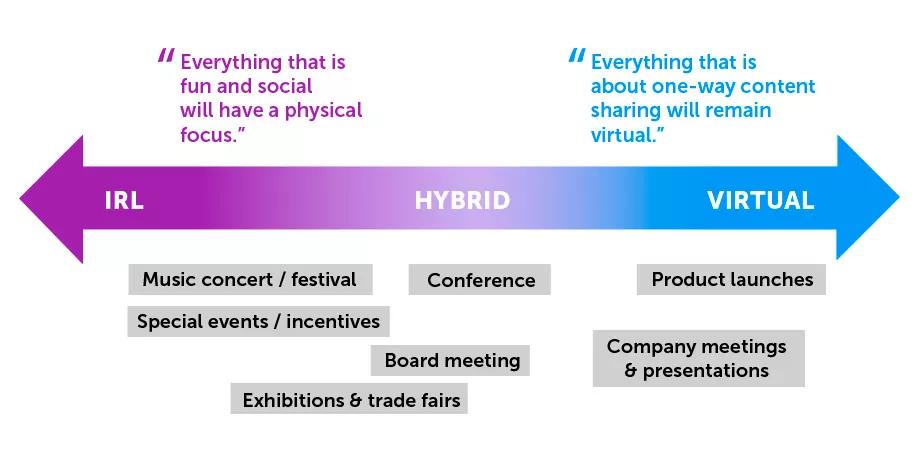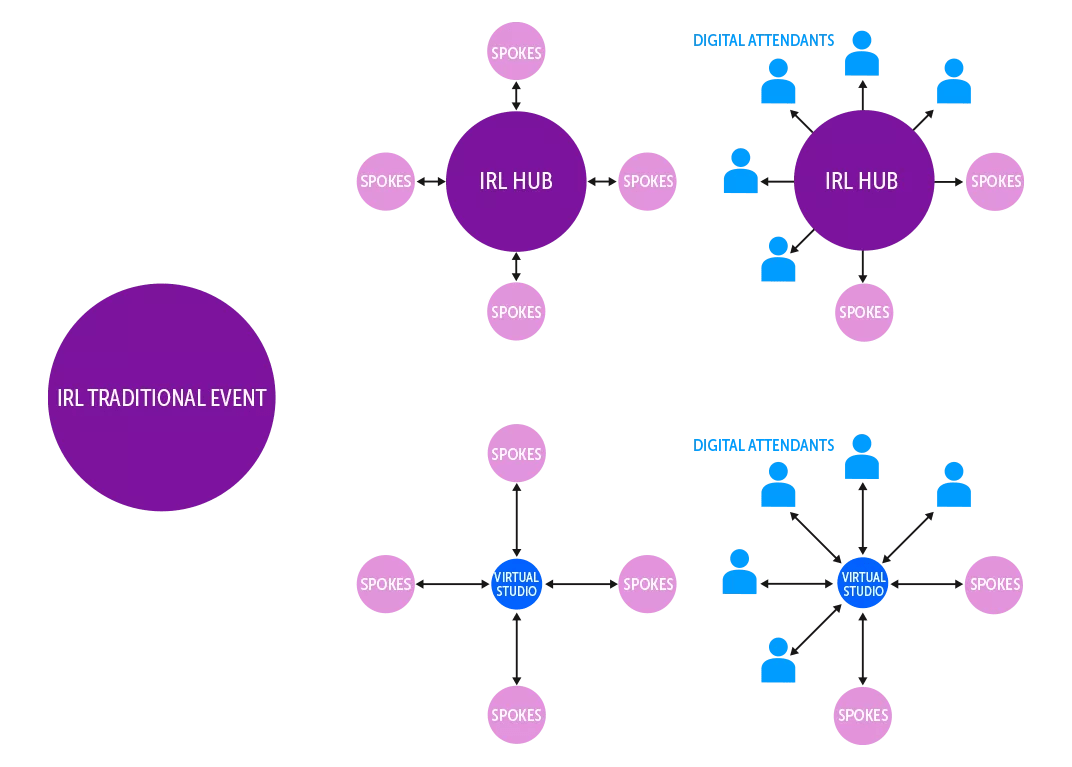On-site, virtual or hybrid: what’s the future of live events?
5 分钟阅读
1920: Gatsbyesque parties, flapper girls and jazz music? Yes, but the roaring twenties were more than that. It was a decade of historical changes in all aspects of social life, culture, economy and technology. One hundred years later, we’re facing a new decade of transformation. You can call it the new normal if you want, or simply the 2020s. We’re only one year in – but what a year! It’s already indisputable that things are not like they were before. New technologies bring remarkable innovations and the covid pandemic has upended most of life and work as we know it. But what we want to look at today is how these seismic shifts will affect the future of events. What do the coming years have in store for the live entertainment industry?
Before 2020, aka before covid, on-site events were the norm. With shelter-in-place and social distancing orders in effect, in-person gatherings were limited or off the table entirely for much of the year. And in the course of 2020, we saw a forced switch from pure on-site events to pure virtual productions. Now, what’s next?
The spectrum of live events
Being pushed to explore the spectrum of live events, we’ve learned that each type has its own advantages and that there’s never one-size-fits-all solution.

Virtual events
Even in the absence of a global health crisis, virtual alternatives offer noteworthy benefits for event organizers, speakers, and attendees. Virtual solutions are perfect for one-way informative events in corporate environments, like product launches and company presentations. They enable organizers to prepare a defined experience and control their story during the event. In addition, virtual platforms give them the opportunity to follow-up attendee interests, capture their data, and nurture leads in ways that would be more difficult to achieve with live-only events. And because virtual events don’t require any travel, you can reach a larger international audience while also cutting in carbon emissions.
IRL events
While virtual alternatives work in certain situations, on-site IRL (in real life) events still offer a level of entertainment and real interaction with other human beings without the interfering factors of failing webcams, muted mics and low-bandwidth issues. When it comes to gatherings that focus on the social aspect, like concerts and festivals but also corporate networking opportunities, on-site events are the go-to solution. Dancing on your own in your room is just not the same thing as jumping in unison with a frenzied audience while your favorite DJ is giving his all on stage...
Live physical events are experiences you don’t want to miss. Be there or be square. They will increasingly focus on high production quality to offer a level of exclusiveness, IRL interaction and immersion, which today you can’t replicate with currently existing virtual platforms.
Hybrid events
If you ever tried to plan a party with friends, you know it’s a challenge to get everyone together on a date that fits the different schedules. Imagine having to organize a boardroom meeting with busy stakeholders or a conference with participants located in different time zones. That’s where hybrid events prove their worth, combining the benefits of on-site events and virtual solutions. Hosting hybrid events provides attendees with multiple options to choose from. This flexibility makes it possible to get more people to participate in your event, even those who choose to stay in the comfort of their home – whether that’s for time management or for ecological reasons. At the same time, it might reduce the incidence of attendee cancellations because instead of canceling, people can just switch to the virtual experience.
The evolution of event types
There’s no doubt we’ll soon see live events coming back, but - you’ve guessed it – not like it was before.
1. Video streams will turn from optional into default.
In the past, live streaming only happened occasionally, but it was certainly on the rise already. According to a roundup of data from Twitch, YouTube, Facebook, Mixer, and Daily Esports, there was a 99% year-over-year growth in hours of live stream video watched between April 2019 and April 2020. This growth has steadily increased throughout 2020 and has shown no sign of tapping the brakes in 2021 with new records and milestones happening across the different livestreaming platforms.
Experts agree that we’ll see more of this video stream trend in the foreseeable future in hybrid applications. The TwitchCon events are a paramount example of how this could work. Every year Twitch hosts an IRL conference in San Diego that brings thousands of fans together. But the conference also has a live streaming element allowing online viewers to soak up the action on the event floor and virtually join the panel discussions, live performances and gaming tournaments. They even invite attendees to capture and co-stream the TwitchCon content.
2. Virtual studios will start growing
It must be said of course that some event professionals were already looking into the possibilities of virtual conferences. But virtual events were still the exception. According to a report commissioned by BizBash and Aventri, 70% of the respondents had less than six virtual events planned for 2020 prior to the spread of COVID-19. Today, that amount is halved to only 32%. In that sense, the covid outbreak has worked as a catalyst for the virtual trend, slightly pushing more organizers to explore the new possibilities for future events.
Caught off guard, many of the event companies turned to quick fix online solutions. But with more and more events moving to the online realm, an increasing number of parties in the industry are building permanent virtual studios. Technological innovations will enable these studios to grow in professionalism and gain ground with improved virtual experiences. AED Group, for instance, recently launched their walk-in on-demand virtual studio that relies on the advantages of Barco’s weConnect virtual classroom platform to enable interactivity and optimized communication in virtual corporate events and big remote meetings.
3. Spoke models become viable
 As the industry rebuilds itself in the aftermath of this crisis, multiple smaller and local events will replace one large global event. Think of ISE2021. In 2020, they had over 116,000 attendees from all over the world to visit the AV tradeshow at the RAI in Amsterdam. This year, they’ve decided to host multiple smaller regional exhibitions complemented with a digital program.
As the industry rebuilds itself in the aftermath of this crisis, multiple smaller and local events will replace one large global event. Think of ISE2021. In 2020, they had over 116,000 attendees from all over the world to visit the AV tradeshow at the RAI in Amsterdam. This year, they’ve decided to host multiple smaller regional exhibitions complemented with a digital program.
This decentralized character tails in with the increasing popularity of Hub and Spoke methods in the event world. In this model, based on the wheel imagery, you’ll find one IRL or virtual hub – the primary stage, so to speak – and different spokes being smaller satellite venues, groups connecting via hybrid technology or individuals tuning in from home.
These smaller events are safer, but they also offer a feeling of intimacy, increase the networking quality and play on the growing need for personalized approaches. (More about this and other audience trends in a next blog post.)
Conclusion
So: on-site, hybrid or virtual. Which one is best for future events? As with so many things, there is no black-or-white answer. The last year has taught the live industry that some events actually work better when virtual, while others are still requiring in-real-life physical interaction. And in the next five years, we’ll see a growing mix of the different event types in which the best of all worlds is combined to bring the best experience possible to the audiences.
*Header image courtesy of Taylor Bennett Partners and Hawthorn


